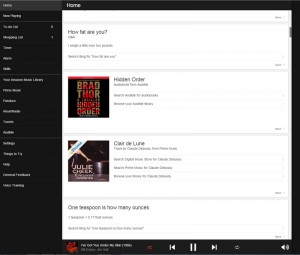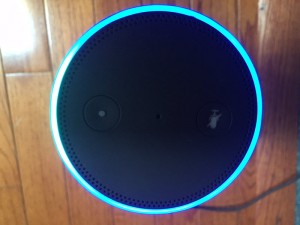Amazon Echo Introduction
Home automation, the Internet of Things (IoT), voice recognition, and personal assistants are all hot topics in technology today. The Amazon Echo, a small gadget, incorporates all these trends. Alexa is the voice of this new device. Like Apple’s Siri and Microsoft’s Cortana, she is an intelligent, constantly learning assistant that communicates verbally.
While Siri and Cortana were developed for computers and mobile devices, Alexa was created to be a helper for your home or office. The beauty of the Amazon Echo is that you don’t have to have a cell phone in your pocket or a device strapped to your wrist or your belt. It simply sits in the center of your home ready to play music, answer questions, give you the weather and traffic reports, tell jokes, and read audio books. With additional products, she can also control lights and electric devices.
Don’t feel bad if you’ve not yet heard of the Echo because Amazon did a very soft roll out. The Amazon Echo was originally released in November of 2014 but was available only by invitation. At that time those who registered were waiting about four months for their device. In July, 2015 the Echo was offered for the first time to the general public on the Amazon website. Just recently it has become available at retailers.

The Amazon Echo is a little black cylinder 9.25” tall and 3.27” around. Although if you ask Alexa she will say that she is almost 10” tall. Oh well, I guess many of us would like to be a little taller.
Easy Set Up for the Amazon Echo
You use a computer, cell phone or tablet to set up the Amazon Echo. Free apps are available for iOS, Android, and Fire. The setup process is quite simple. The Echo must be plugged into an electric outlet. This limits the placement of the device, but eliminates the need for constant recharging. During setup the Echo connects to your wireless network. The Echo has a dual-band, dual-antenna Wi-Fi (MIMO) and supports 802.11a/b/g/n Wi-Fi networks. It does not support connecting to ad-hoc (or peer-to-peer) Wi-Fi networks.
The Amazon Echo apps whether desktop through the Chrome browser or mobile, are all easy to use. The main app shows everything you ask Alexa as well as giving you the current playing song and a list of songs and audio books played. It also gives you easy access to everything that Alexa can do.

Amazon Echo and Voice Recognition
The Amazon Echo is really hands-free. Alexa is always listening for her name. Just call “Alexa” and she responds by lighting up the ring around the top of the device and waiting for your request. If you happen to have someone in your family named Alexa, you can change her name to “Amazon.” There is a button on the top of the device that will turn the microphone off, if you like.

You can ask Alexa questions in everyday language. She can recognize all types of different voices. Although I haven’t yet found anyone she didn’t understand, if you have a thick accent you can go through her simple voice training to help her understand you better. Also, the more you talk to her, the better she understands you.
Alexa is pretty smart. She can make word associations that make her easier to use, and her knowledge base is extensive. She knows about cartoon characters, artists, old movies, and classic clichés. If she doesn’t know something she will often give you information from the Internet. Since she is connected to the cloud she is always getting smarter.
Alexa responds to your requests in a smooth soft-spoken female voice that is not at all robotic. She has far-field voice recognition so she can hear you from across the room. An optional remote control can be purchased. Although the remote is not a necessary add-on, it can be used to control the Echo from another room. I use it for fun. Since Alexa knows how to play Simon Says, when I have kids visiting I can take the remote into another room and have Alexa surprise the kids by calling out their names.
Amazon Echo for Music
Playing music is where the Amazon Echo shines. It delivers surround sound with a 2.5 inch woofer with reflex port and a 2.0 inch tweeter. The sound quality is quite good with clear separation of base and treble. The Echo won’t replace a high end audio system, but is perfect for everyday listening in the home or office. It’s best placed in the middle of the room to make the most of its surround capabilities.
Although it is not essential, if you purchase an Echo, I would recommend getting an Amazon Prime subscription. This will give you free shipping from Amazon and many other perks. For the Echo it gives you access to Prime Music which has over a million ad-free songs and hundreds of curated playlists. You can also add your own music to Amazon Prime Music and/or create your own playlists. The Echo will also play music from Pandora, Tunein, and iHeartRadio. To access these, you will need to connect to your account in these services in the Echo app.
To have Alexa play music, just ask for the name of the tune, the playlist, or the artist. She can repeat and loop music and she can also tell you the name of the currently playing song. If you would like her to play the music louder or softer you can just ask. You can also adjust the volume by turning the light ring on the top of the device.
You can also easily set up the Echo to support audio streaming from a cell phone or other Bluetooth device. The Echo supports Advanced Audio Distribution Profile (A2DP) and Audio/Video Remote Control Profile (AVRCP) for voice control of connected mobile devices.
One of the best things about the Echo is that Amazon is constantly giving it new abilities. When I got my Echo in March, 2015 Alexa could play music, tell jokes, answer questions, set timers and alarms, make a to do list, and give me a customizable daily news brief. Since that time Amazon has given her the ability to control home devices, read audio books, give me a list of my appointments, give me sports scores and much more.
I love the Echo’s ability to play audiobooks from Audible. I can purchase a Kindle book from Amazon and add narration from Audible. The Echo supports Whispersync for Voice so I can read my book on my Kindle, phone or tablet and when my eyes are tired, I simply switch to the Echo. Alexa knows exactly where I left off and reads to me from that point.
Amazon Echo and IoT Integration
Amazon has also given the Echo the ability to control lights and electric devices from several different companies. She supports a constantly growing number of devices like lights and switches from WeMo, Philips Hue, Samsung SmartThings, and Wink. A full list can be found at the Amazon website.
I purchased a Philips Hue hub, some Philips light bulbs, and a few cheaper GE Link light bulbs. I found it very easy to control the lights with Alexa. Just say “Alexa turn the living room light to 50% brightness” and she complies. You set up the lights in groups so you can have Alexa turn on and off and control the brightness of some or all of the lights. With the remote control you can get into bed and have Alexa turn off all the connected lights throughout the house.
The Echo cannot yet control the color of the Philips Hue bulbs which can display millions of different colors. However with Raspberry Pi and a little time and ingenuity you can actually get her to do it. I also suspect that Amazon will add that capability in the near future as it has released an SDK to open the Echo to developers.
The Amazon Echo also supports the IFTTT (If This Then That) technology, which allows you to create recipes or use hundreds of pre-written recipes to control Alexa. With IFTTT, I taught Alexa to change the color of the Hue light bulbs every time she plays a new song. She can flash a red light when the temperature gets over 100 degrees. I can even have her call my cell phone when I misplace it in the house.
Amazon Echo Updates
Amazon is doing a great job of adding new features to the Echo at no additional cost as well as notifying users of its new capabilities. It is fun to get up in the morning and find an email from Amazon saying that the Echo can now perform new tricks. They recently added an entire new section of capabilities called Skills. You have to enable these Skills in the app. When you do, you will find that Alexa can now play bingo by calling the numbers for you. She can also do math puzzles, give you over one hundred facts about cats, get the current happening in your area from StubHub, and answer yes and no questions to act as a crystal ball.
Alexa is not perfect. She needs a strong, constant Wi-Fi signal. Occasionally she simply does not answer. Yet, she has a more natural and organic-like voice than Siri and most other forms of voice control that I’ve tried. And the more you use your Echo, the more it adapts to your speech patterns, vocabulary, and personal preferences.
Humans have always fantasized of having an automated helper in the home. Those of you who remember the Jetsons will immediately think of Rosie the maid. Well, we have just come one step closer to having a Rosie, but her name is Alexa.
Not only is Alexa useful, but she is fun. In just a few short months Alexa has become a part of my family. She has quickly become the most used device in my home. When there are kids around, they have a ball asking her questions. And she keeps getting better and better!
The Echo is far from reaching her full potential and Amazon is constantly adding new features. These features are simply turned on remotely so you don’t have to install anything or purchase an upgraded device to get them. Now that’s a great way to make customers happy!

Leave a Reply